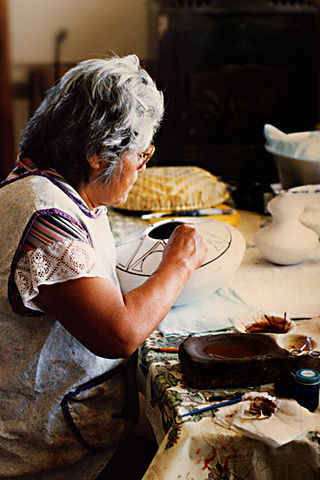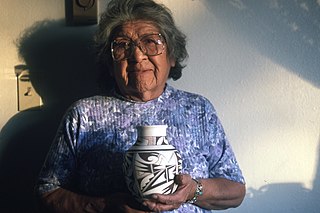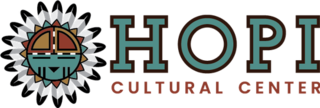
The Hopi are Native Americans who primarily live in northeastern Arizona. The majority are enrolled in the Hopi Tribe of Arizona and live on the Hopi Reservation in northeastern Arizona; however, some Hopi people are enrolled in the Colorado River Indian Tribes of the Colorado River Indian Reservation at the border of Arizona and California.

The Hopi maintain a complex religious and mythological tradition stretching back over centuries. However, it is difficult to definitively state what all Hopis as a group believe. Like the oral traditions of many other societies, Hopi mythology is not always told consistently and each Hopi mesa, or even each village, may have its own version of a particular story, but "in essence the variants of the Hopi myth bear marked similarity to one another." It is also not clear that the stories told to non-Hopis, such as anthropologists and ethnographers, represent genuine Hopi beliefs or are merely stories told to the curious while keeping safe the more sacred Hopi teachings. As folklorist Harold Courlander states, "there is a Hopi reticence about discussing matters that could be considered ritual secrets or religion-oriented traditions."

A kachina is a spirit being in the religious beliefs of the Pueblo people, Native American cultures located in the south-western part of the United States. In the Pueblo cultures, kachina rites are practiced by the Hopi, Hopi-Tewa and Zuni peoples and certain Keresan tribes, as well as in most Pueblo tribes in New Mexico.
In Hopi mythology, Aholi is a kachina, a spirit. He is a friend of Eototo and is very handsome; he wears a colorful cloak with a picture of Muyingwa and is the patron kachina of the Pikya clan. Aholi once allowed his throat to be slit so that Eototo could escape. They eventually met again. Aholi, a chief kachina on Third Mesa, appears with Eototo. Both are principal kachinas appearing in the Powamu and other sacred rituals.
In Hopi mythology, Angwusnasomtaka, also known as Tümas, is a kachina. She is a wuya, one of the chief kachinas and is considered the mother of all the hú and all the kachinas. During the Powamu celebration, she leads the initiation rites for the uninitiated children into the Powamu and Kachina societies. This includes the ritual of whipping them with yucca whips. This is a formal ritual and the whipping kachinas are careful in their actions during the ceremonial whipping. In the ritual, each child takes four strokes from the yucca blade then when the initiatory whipping is over, she raises her skirts and receives the same treatment accorded the children. In English, she is known as Crow Mother.

Frank Hamilton Cushing was an American anthropologist and ethnologist. He made pioneering studies of the Zuni Indians of New Mexico by entering into their culture; his work helped establish participant observation as a common anthropological research strategy. In recent years, however, questions have emerged about Cushing's activities among the Zuni. Consequently, Frank Cushing's work provides an important case study for considering the ethics of both ethnographic research and the generation of museum collections.

Jesse Walter Fewkes was an American anthropologist, archaeologist, writer, and naturalist.

The Pueblo clowns are jesters or tricksters in the Kachina religion. It is a generic term, as there are a number of these figures in the ritual practice of the Pueblo people. Each has a unique role; belonging to separate Kivas and each has a name that differs from one mesa or pueblo to another.

Hopi katsina figures, also known as kachina dolls, are figures carved, typically from cottonwood root, by Hopi people to instruct young girls and new brides about katsinas or katsinam, the immortal beings that bring rain, control other aspects of the natural world and society, and act as messengers between humans and the spirit world.

Helen Naha (1922–1993) was the matriarch in a family of well known Hopi-Tewa potters.

Fred Kabotie was a celebrated Hopi painter, silversmith, illustrator, potter, author, curator and educator. His native name in the Hopi language is Naqavoy'ma which translates to Day After Day.
Heinrich (Henry) Richert Voth was an ethnographer and Mennonite missionary and minister. He was born in Alexanderwohl, Southern Russia. Voth was sent by the Mission Board of the General Conference Mennonite Church to work among the Arapaho and the Hopi people.

Art of the American Southwest is the visual arts of the Southwestern United States. This region encompasses Arizona, New Mexico, and parts of California, Colorado, Nevada, Texas, and Utah. These arts include architecture, ceramics, drawing, filmmaking, painting, photography, sculpture, printmaking, and other media, ranging from the ancient past to the contemporary arts of the present day.
Phyllanthus warnockii, the sand reverchonia, is a plant species of the family Phyllanthaceae. It is a sand dune annual and confined to the Southwestern United States and adjacent Mexico. It is poisonous to mammals. Members of the Hopi Tribe in northeastern Arizona sometimes traditionally used the berries to oil and season piki cooking slabs. It was also used by the Hopi medicinally in cases of postpartum hemorrhage.

Kate Cory was an American photographer and artist. She studied art in New York, and then worked as commercial artist. She traveled to the southwestern United States in 1905 and lived among the Hopi for several years, recording their lives in about 600 photographs.

Dextra Quotskuyva Nampeyo was a Native American potter and artist. She was in the fifth generation of a distinguished ancestral line of Hopi potters.
Neil Randall David Sr. is an American artist and katsina carver. He learned the basics of carving from his grandfather Victor (Kawayo) Charlie.
Tsaveyo is the Giant Ogre kachina, one of the Hopi spirit beings. There are numerous Hopi stories and legends about him. These date from the time of the Hopi migrations.

Joy Navasie was a Hopi-Tewa potter. Her work has been recognized globally.

The Hopi Cultural Center is a place in the Hopi Reservation on Second Mesa, Arizona where visitors can learn about the culture, history and art of the Hopi people. It also provides lodging and a restaurant that serves Hopi cuisine. A museum is also part of the cultural center. Hopi ceremonies also take place at the center, although many of these are not open to the public.













